Monash University MGF5640: Cross-Cultural Communication Report
VerifiedAdded on 2023/06/03
|16
|3991
|54
Report
AI Summary
This report provides an in-depth analysis of cross-cultural communication, focusing on intercultural communication and its associated barriers, as well as the critical link between language and culture. It delves into the positive and negative impacts of intercultural communication in international work environments, highlighting the challenges of language barriers. The report explores the relationship between language and culture, emphasizing the significance of language in business settings and the use of verbal and non-verbal communication. Theoretical reflections include discussions of Hofstede's cultural dimensions, identifying power distance, masculinity vs. femininity, and individualism vs. collectivism as key factors. The Shannon Weaver model of communication is also evaluated. Practical reflections are included, discussing the application of these concepts in the real world, addressing issues such as workplace diversity and language barriers, with personal experiences and training programs. The report provides alternative approaches to overcome communication barriers, such as training and interpersonal communication, and concludes with practical insights and recommendations for effective cross-cultural management.
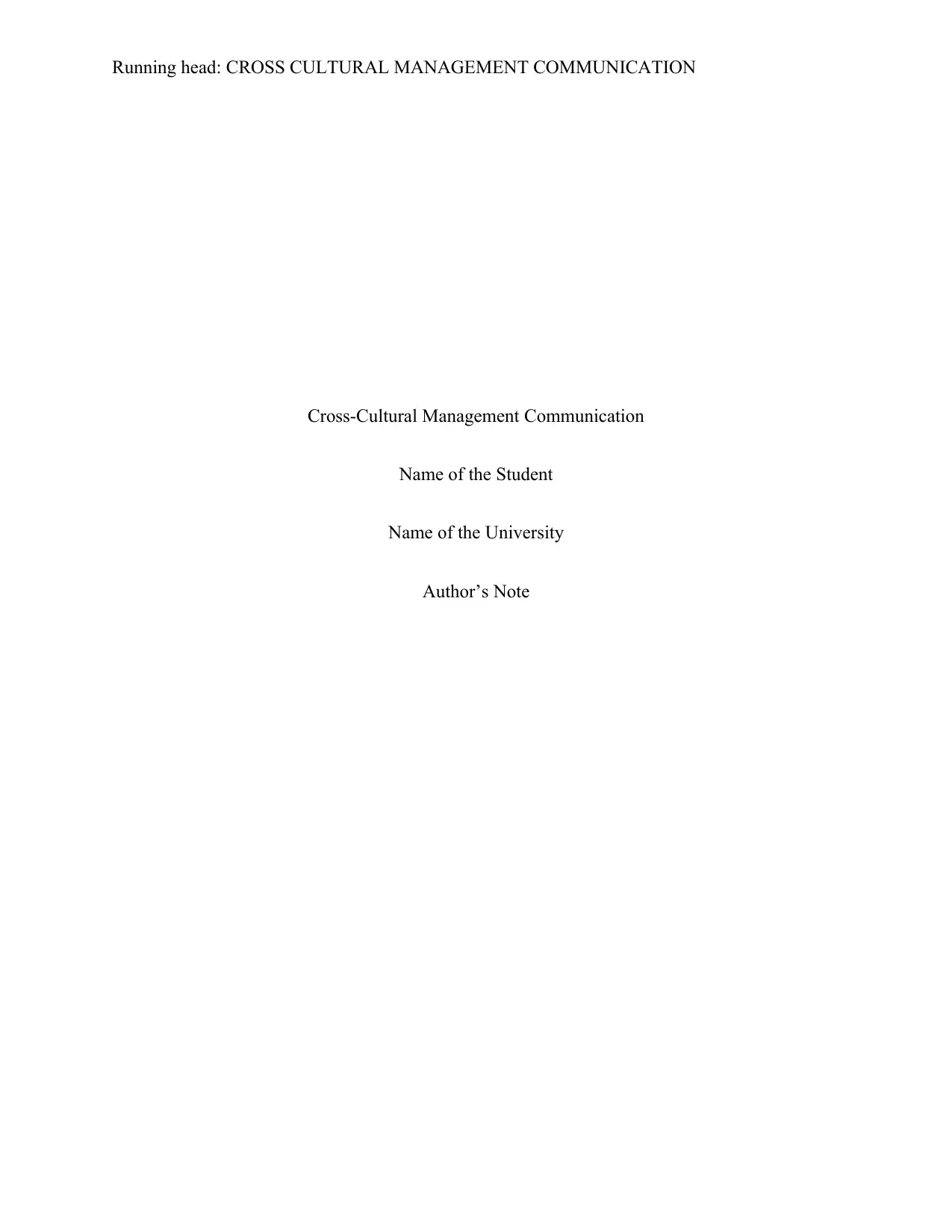
Running head: CROSS CULTURAL MANAGEMENT COMMUNICATION
Cross-Cultural Management Communication
Name of the Student
Name of the University
Author’s Note
Cross-Cultural Management Communication
Name of the Student
Name of the University
Author’s Note
Paraphrase This Document
Need a fresh take? Get an instant paraphrase of this document with our AI Paraphraser
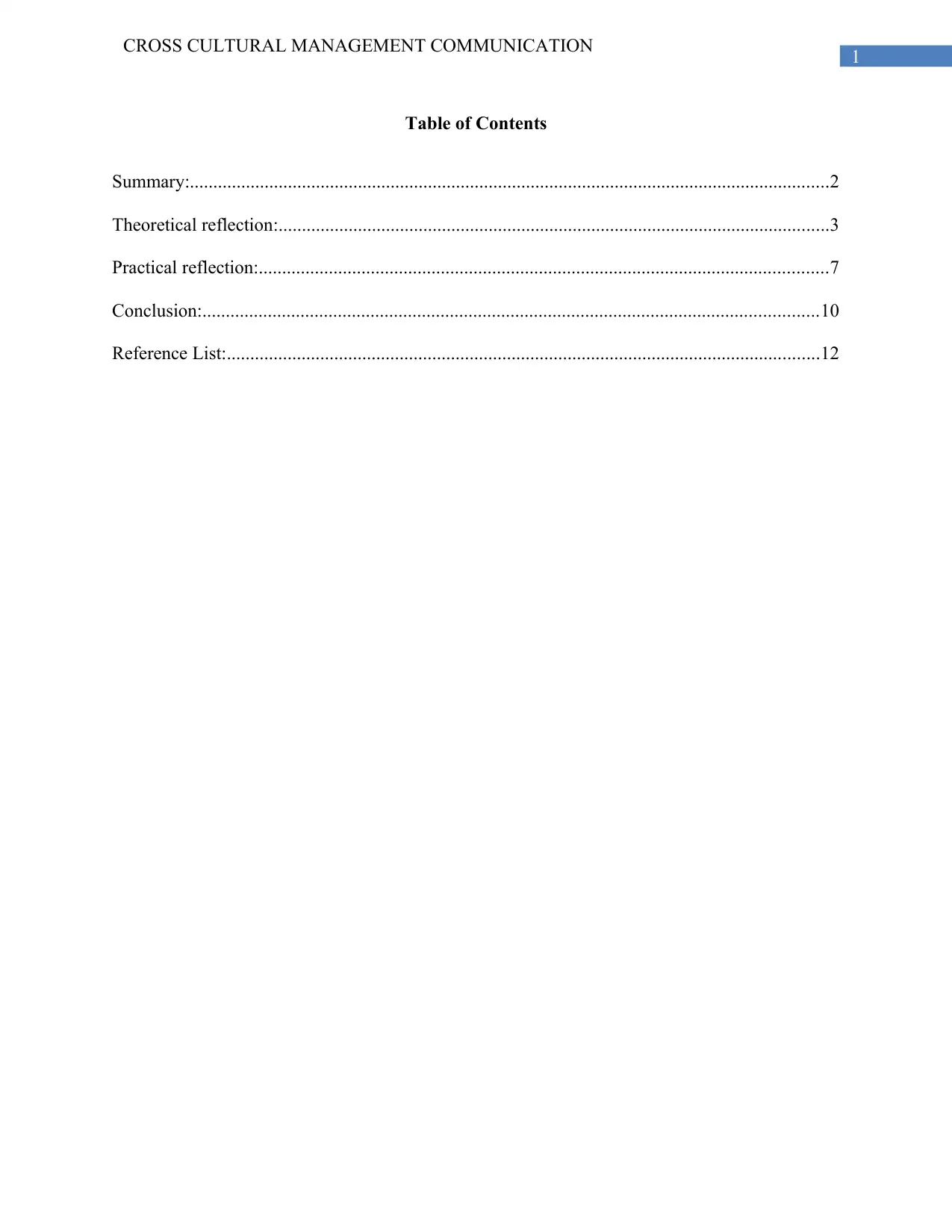
1
CROSS CULTURAL MANAGEMENT COMMUNICATION
Table of Contents
Summary:.........................................................................................................................................2
Theoretical reflection:......................................................................................................................3
Practical reflection:..........................................................................................................................7
Conclusion:....................................................................................................................................10
Reference List:...............................................................................................................................12
CROSS CULTURAL MANAGEMENT COMMUNICATION
Table of Contents
Summary:.........................................................................................................................................2
Theoretical reflection:......................................................................................................................3
Practical reflection:..........................................................................................................................7
Conclusion:....................................................................................................................................10
Reference List:...............................................................................................................................12
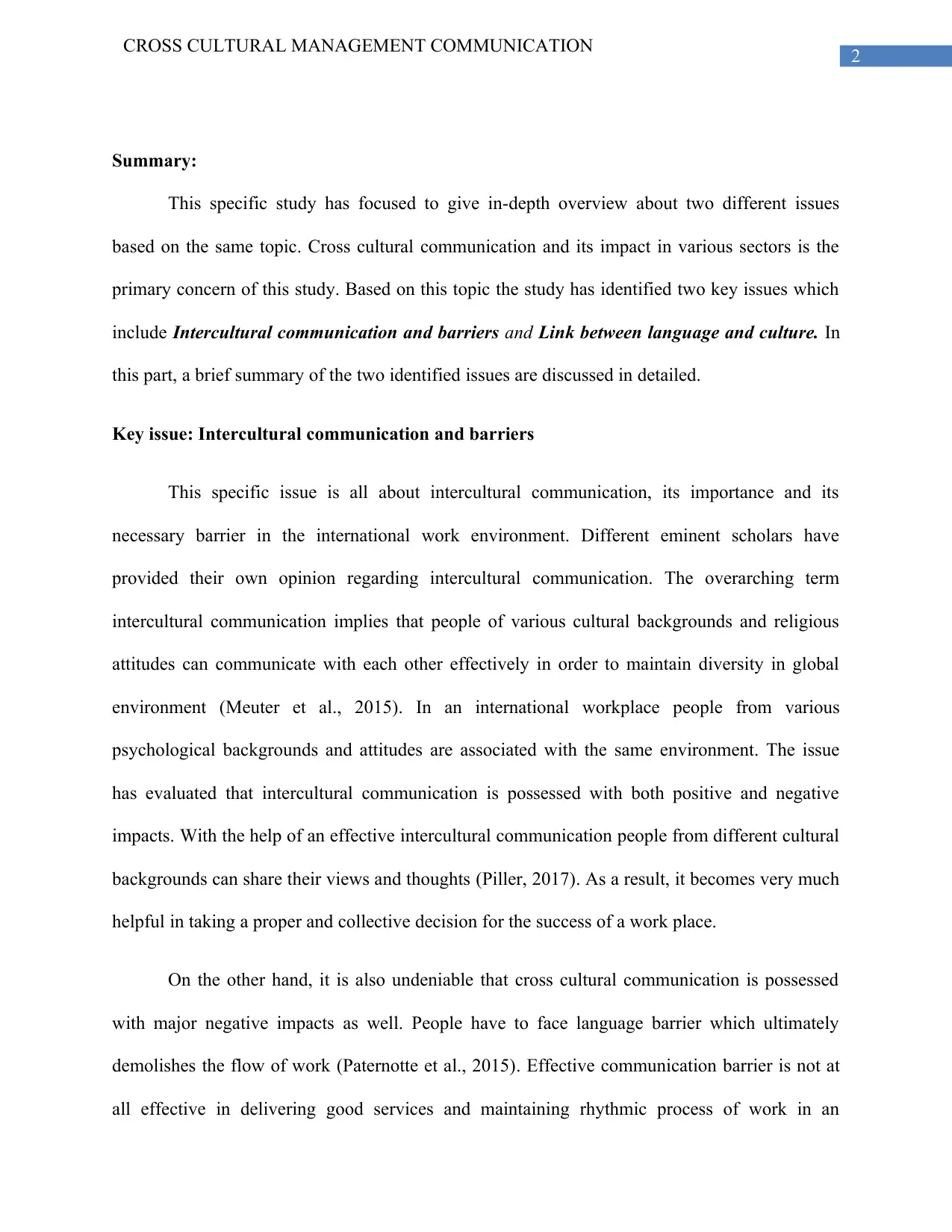
2
CROSS CULTURAL MANAGEMENT COMMUNICATION
Summary:
This specific study has focused to give in-depth overview about two different issues
based on the same topic. Cross cultural communication and its impact in various sectors is the
primary concern of this study. Based on this topic the study has identified two key issues which
include Intercultural communication and barriers and Link between language and culture. In
this part, a brief summary of the two identified issues are discussed in detailed.
Key issue: Intercultural communication and barriers
This specific issue is all about intercultural communication, its importance and its
necessary barrier in the international work environment. Different eminent scholars have
provided their own opinion regarding intercultural communication. The overarching term
intercultural communication implies that people of various cultural backgrounds and religious
attitudes can communicate with each other effectively in order to maintain diversity in global
environment (Meuter et al., 2015). In an international workplace people from various
psychological backgrounds and attitudes are associated with the same environment. The issue
has evaluated that intercultural communication is possessed with both positive and negative
impacts. With the help of an effective intercultural communication people from different cultural
backgrounds can share their views and thoughts (Piller, 2017). As a result, it becomes very much
helpful in taking a proper and collective decision for the success of a work place.
On the other hand, it is also undeniable that cross cultural communication is possessed
with major negative impacts as well. People have to face language barrier which ultimately
demolishes the flow of work (Paternotte et al., 2015). Effective communication barrier is not at
all effective in delivering good services and maintaining rhythmic process of work in an
CROSS CULTURAL MANAGEMENT COMMUNICATION
Summary:
This specific study has focused to give in-depth overview about two different issues
based on the same topic. Cross cultural communication and its impact in various sectors is the
primary concern of this study. Based on this topic the study has identified two key issues which
include Intercultural communication and barriers and Link between language and culture. In
this part, a brief summary of the two identified issues are discussed in detailed.
Key issue: Intercultural communication and barriers
This specific issue is all about intercultural communication, its importance and its
necessary barrier in the international work environment. Different eminent scholars have
provided their own opinion regarding intercultural communication. The overarching term
intercultural communication implies that people of various cultural backgrounds and religious
attitudes can communicate with each other effectively in order to maintain diversity in global
environment (Meuter et al., 2015). In an international workplace people from various
psychological backgrounds and attitudes are associated with the same environment. The issue
has evaluated that intercultural communication is possessed with both positive and negative
impacts. With the help of an effective intercultural communication people from different cultural
backgrounds can share their views and thoughts (Piller, 2017). As a result, it becomes very much
helpful in taking a proper and collective decision for the success of a work place.
On the other hand, it is also undeniable that cross cultural communication is possessed
with major negative impacts as well. People have to face language barrier which ultimately
demolishes the flow of work (Paternotte et al., 2015). Effective communication barrier is not at
all effective in delivering good services and maintaining rhythmic process of work in an
⊘ This is a preview!⊘
Do you want full access?
Subscribe today to unlock all pages.

Trusted by 1+ million students worldwide
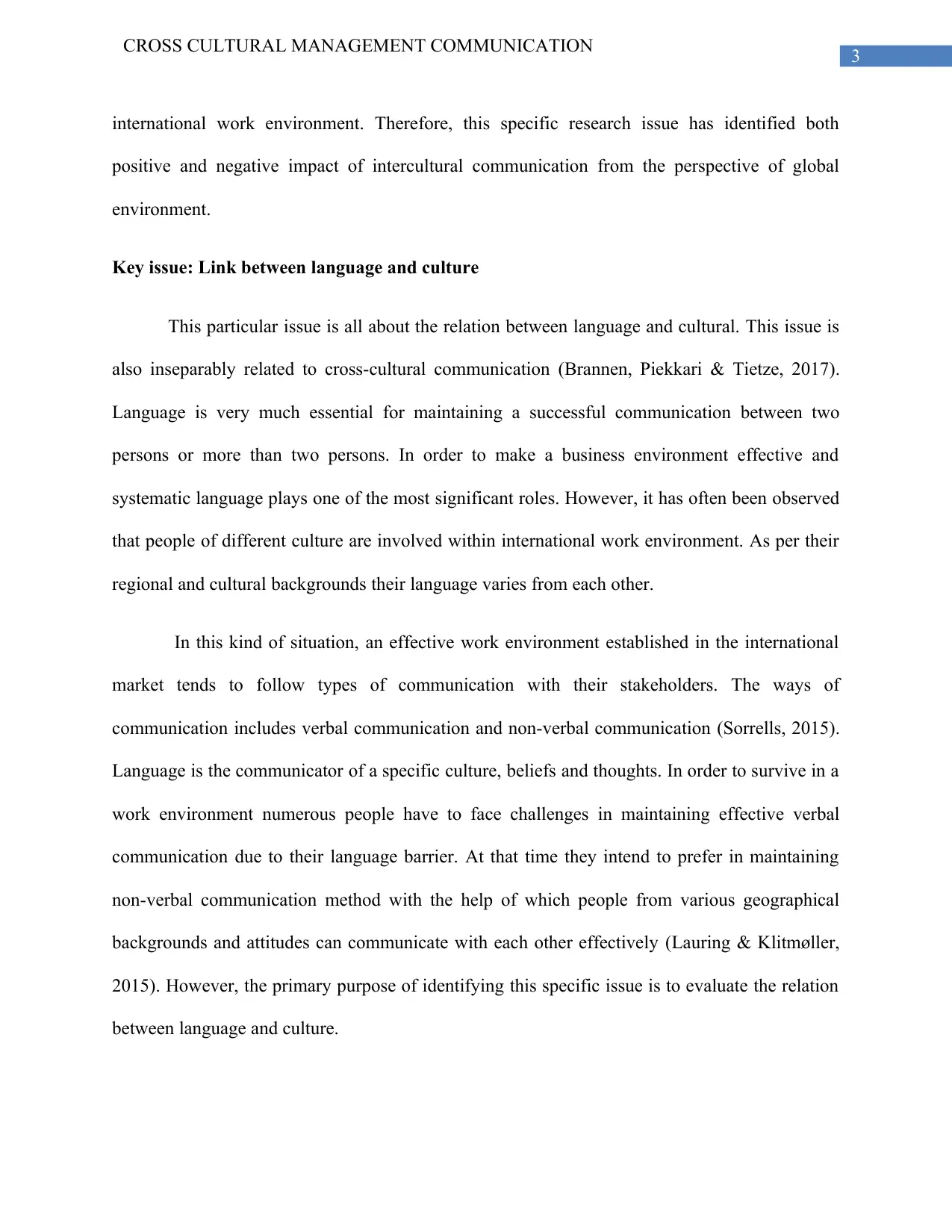
3
CROSS CULTURAL MANAGEMENT COMMUNICATION
international work environment. Therefore, this specific research issue has identified both
positive and negative impact of intercultural communication from the perspective of global
environment.
Key issue: Link between language and culture
This particular issue is all about the relation between language and cultural. This issue is
also inseparably related to cross-cultural communication (Brannen, Piekkari & Tietze, 2017).
Language is very much essential for maintaining a successful communication between two
persons or more than two persons. In order to make a business environment effective and
systematic language plays one of the most significant roles. However, it has often been observed
that people of different culture are involved within international work environment. As per their
regional and cultural backgrounds their language varies from each other.
In this kind of situation, an effective work environment established in the international
market tends to follow types of communication with their stakeholders. The ways of
communication includes verbal communication and non-verbal communication (Sorrells, 2015).
Language is the communicator of a specific culture, beliefs and thoughts. In order to survive in a
work environment numerous people have to face challenges in maintaining effective verbal
communication due to their language barrier. At that time they intend to prefer in maintaining
non-verbal communication method with the help of which people from various geographical
backgrounds and attitudes can communicate with each other effectively (Lauring & Klitmøller,
2015). However, the primary purpose of identifying this specific issue is to evaluate the relation
between language and culture.
CROSS CULTURAL MANAGEMENT COMMUNICATION
international work environment. Therefore, this specific research issue has identified both
positive and negative impact of intercultural communication from the perspective of global
environment.
Key issue: Link between language and culture
This particular issue is all about the relation between language and cultural. This issue is
also inseparably related to cross-cultural communication (Brannen, Piekkari & Tietze, 2017).
Language is very much essential for maintaining a successful communication between two
persons or more than two persons. In order to make a business environment effective and
systematic language plays one of the most significant roles. However, it has often been observed
that people of different culture are involved within international work environment. As per their
regional and cultural backgrounds their language varies from each other.
In this kind of situation, an effective work environment established in the international
market tends to follow types of communication with their stakeholders. The ways of
communication includes verbal communication and non-verbal communication (Sorrells, 2015).
Language is the communicator of a specific culture, beliefs and thoughts. In order to survive in a
work environment numerous people have to face challenges in maintaining effective verbal
communication due to their language barrier. At that time they intend to prefer in maintaining
non-verbal communication method with the help of which people from various geographical
backgrounds and attitudes can communicate with each other effectively (Lauring & Klitmøller,
2015). However, the primary purpose of identifying this specific issue is to evaluate the relation
between language and culture.
Paraphrase This Document
Need a fresh take? Get an instant paraphrase of this document with our AI Paraphraser
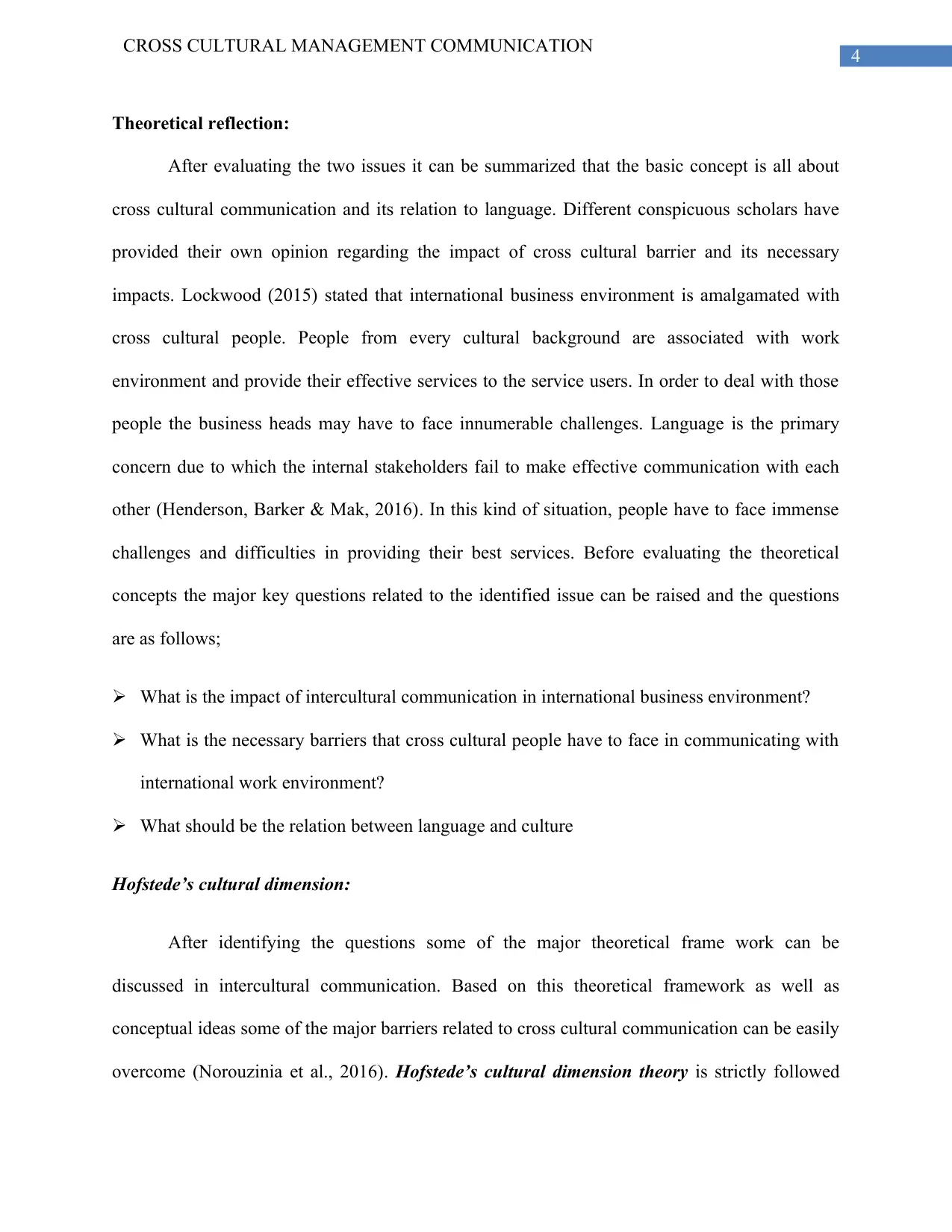
4
CROSS CULTURAL MANAGEMENT COMMUNICATION
Theoretical reflection:
After evaluating the two issues it can be summarized that the basic concept is all about
cross cultural communication and its relation to language. Different conspicuous scholars have
provided their own opinion regarding the impact of cross cultural barrier and its necessary
impacts. Lockwood (2015) stated that international business environment is amalgamated with
cross cultural people. People from every cultural background are associated with work
environment and provide their effective services to the service users. In order to deal with those
people the business heads may have to face innumerable challenges. Language is the primary
concern due to which the internal stakeholders fail to make effective communication with each
other (Henderson, Barker & Mak, 2016). In this kind of situation, people have to face immense
challenges and difficulties in providing their best services. Before evaluating the theoretical
concepts the major key questions related to the identified issue can be raised and the questions
are as follows;
What is the impact of intercultural communication in international business environment?
What is the necessary barriers that cross cultural people have to face in communicating with
international work environment?
What should be the relation between language and culture
Hofstede’s cultural dimension:
After identifying the questions some of the major theoretical frame work can be
discussed in intercultural communication. Based on this theoretical framework as well as
conceptual ideas some of the major barriers related to cross cultural communication can be easily
overcome (Norouzinia et al., 2016). Hofstede’s cultural dimension theory is strictly followed
CROSS CULTURAL MANAGEMENT COMMUNICATION
Theoretical reflection:
After evaluating the two issues it can be summarized that the basic concept is all about
cross cultural communication and its relation to language. Different conspicuous scholars have
provided their own opinion regarding the impact of cross cultural barrier and its necessary
impacts. Lockwood (2015) stated that international business environment is amalgamated with
cross cultural people. People from every cultural background are associated with work
environment and provide their effective services to the service users. In order to deal with those
people the business heads may have to face innumerable challenges. Language is the primary
concern due to which the internal stakeholders fail to make effective communication with each
other (Henderson, Barker & Mak, 2016). In this kind of situation, people have to face immense
challenges and difficulties in providing their best services. Before evaluating the theoretical
concepts the major key questions related to the identified issue can be raised and the questions
are as follows;
What is the impact of intercultural communication in international business environment?
What is the necessary barriers that cross cultural people have to face in communicating with
international work environment?
What should be the relation between language and culture
Hofstede’s cultural dimension:
After identifying the questions some of the major theoretical frame work can be
discussed in intercultural communication. Based on this theoretical framework as well as
conceptual ideas some of the major barriers related to cross cultural communication can be easily
overcome (Norouzinia et al., 2016). Hofstede’s cultural dimension theory is strictly followed
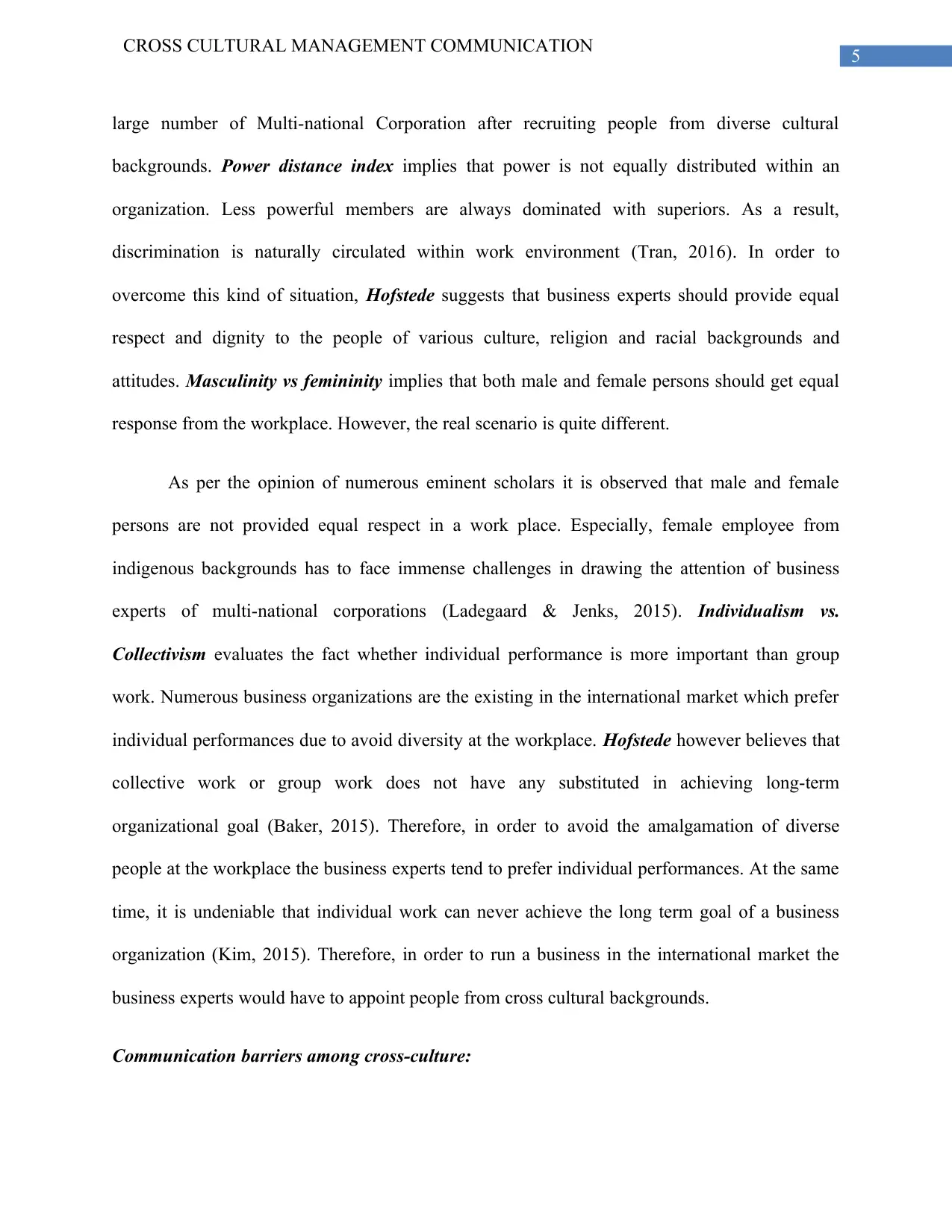
5
CROSS CULTURAL MANAGEMENT COMMUNICATION
large number of Multi-national Corporation after recruiting people from diverse cultural
backgrounds. Power distance index implies that power is not equally distributed within an
organization. Less powerful members are always dominated with superiors. As a result,
discrimination is naturally circulated within work environment (Tran, 2016). In order to
overcome this kind of situation, Hofstede suggests that business experts should provide equal
respect and dignity to the people of various culture, religion and racial backgrounds and
attitudes. Masculinity vs femininity implies that both male and female persons should get equal
response from the workplace. However, the real scenario is quite different.
As per the opinion of numerous eminent scholars it is observed that male and female
persons are not provided equal respect in a work place. Especially, female employee from
indigenous backgrounds has to face immense challenges in drawing the attention of business
experts of multi-national corporations (Ladegaard & Jenks, 2015). Individualism vs.
Collectivism evaluates the fact whether individual performance is more important than group
work. Numerous business organizations are the existing in the international market which prefer
individual performances due to avoid diversity at the workplace. Hofstede however believes that
collective work or group work does not have any substituted in achieving long-term
organizational goal (Baker, 2015). Therefore, in order to avoid the amalgamation of diverse
people at the workplace the business experts tend to prefer individual performances. At the same
time, it is undeniable that individual work can never achieve the long term goal of a business
organization (Kim, 2015). Therefore, in order to run a business in the international market the
business experts would have to appoint people from cross cultural backgrounds.
Communication barriers among cross-culture:
CROSS CULTURAL MANAGEMENT COMMUNICATION
large number of Multi-national Corporation after recruiting people from diverse cultural
backgrounds. Power distance index implies that power is not equally distributed within an
organization. Less powerful members are always dominated with superiors. As a result,
discrimination is naturally circulated within work environment (Tran, 2016). In order to
overcome this kind of situation, Hofstede suggests that business experts should provide equal
respect and dignity to the people of various culture, religion and racial backgrounds and
attitudes. Masculinity vs femininity implies that both male and female persons should get equal
response from the workplace. However, the real scenario is quite different.
As per the opinion of numerous eminent scholars it is observed that male and female
persons are not provided equal respect in a work place. Especially, female employee from
indigenous backgrounds has to face immense challenges in drawing the attention of business
experts of multi-national corporations (Ladegaard & Jenks, 2015). Individualism vs.
Collectivism evaluates the fact whether individual performance is more important than group
work. Numerous business organizations are the existing in the international market which prefer
individual performances due to avoid diversity at the workplace. Hofstede however believes that
collective work or group work does not have any substituted in achieving long-term
organizational goal (Baker, 2015). Therefore, in order to avoid the amalgamation of diverse
people at the workplace the business experts tend to prefer individual performances. At the same
time, it is undeniable that individual work can never achieve the long term goal of a business
organization (Kim, 2015). Therefore, in order to run a business in the international market the
business experts would have to appoint people from cross cultural backgrounds.
Communication barriers among cross-culture:
⊘ This is a preview!⊘
Do you want full access?
Subscribe today to unlock all pages.

Trusted by 1+ million students worldwide
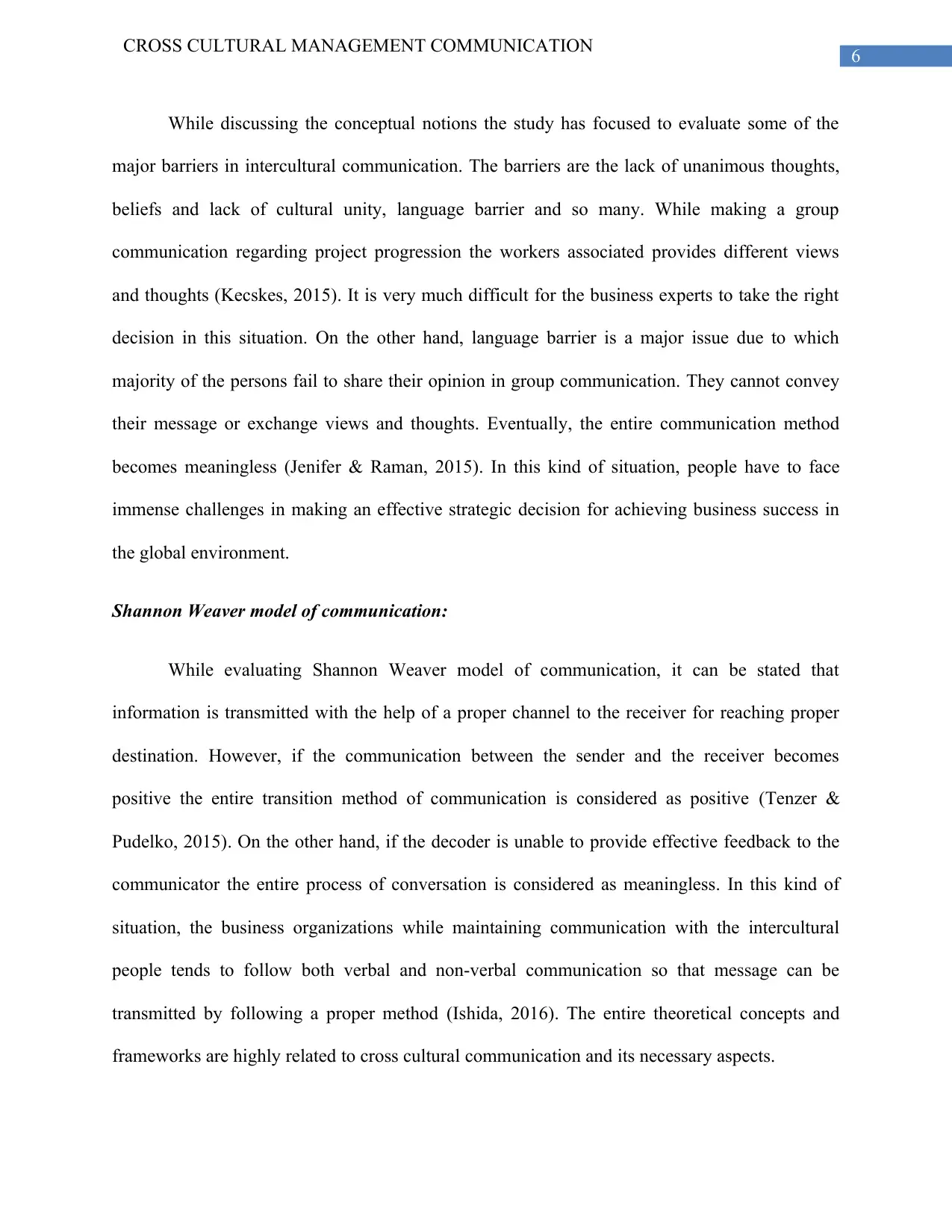
6
CROSS CULTURAL MANAGEMENT COMMUNICATION
While discussing the conceptual notions the study has focused to evaluate some of the
major barriers in intercultural communication. The barriers are the lack of unanimous thoughts,
beliefs and lack of cultural unity, language barrier and so many. While making a group
communication regarding project progression the workers associated provides different views
and thoughts (Kecskes, 2015). It is very much difficult for the business experts to take the right
decision in this situation. On the other hand, language barrier is a major issue due to which
majority of the persons fail to share their opinion in group communication. They cannot convey
their message or exchange views and thoughts. Eventually, the entire communication method
becomes meaningless (Jenifer & Raman, 2015). In this kind of situation, people have to face
immense challenges in making an effective strategic decision for achieving business success in
the global environment.
Shannon Weaver model of communication:
While evaluating Shannon Weaver model of communication, it can be stated that
information is transmitted with the help of a proper channel to the receiver for reaching proper
destination. However, if the communication between the sender and the receiver becomes
positive the entire transition method of communication is considered as positive (Tenzer &
Pudelko, 2015). On the other hand, if the decoder is unable to provide effective feedback to the
communicator the entire process of conversation is considered as meaningless. In this kind of
situation, the business organizations while maintaining communication with the intercultural
people tends to follow both verbal and non-verbal communication so that message can be
transmitted by following a proper method (Ishida, 2016). The entire theoretical concepts and
frameworks are highly related to cross cultural communication and its necessary aspects.
CROSS CULTURAL MANAGEMENT COMMUNICATION
While discussing the conceptual notions the study has focused to evaluate some of the
major barriers in intercultural communication. The barriers are the lack of unanimous thoughts,
beliefs and lack of cultural unity, language barrier and so many. While making a group
communication regarding project progression the workers associated provides different views
and thoughts (Kecskes, 2015). It is very much difficult for the business experts to take the right
decision in this situation. On the other hand, language barrier is a major issue due to which
majority of the persons fail to share their opinion in group communication. They cannot convey
their message or exchange views and thoughts. Eventually, the entire communication method
becomes meaningless (Jenifer & Raman, 2015). In this kind of situation, people have to face
immense challenges in making an effective strategic decision for achieving business success in
the global environment.
Shannon Weaver model of communication:
While evaluating Shannon Weaver model of communication, it can be stated that
information is transmitted with the help of a proper channel to the receiver for reaching proper
destination. However, if the communication between the sender and the receiver becomes
positive the entire transition method of communication is considered as positive (Tenzer &
Pudelko, 2015). On the other hand, if the decoder is unable to provide effective feedback to the
communicator the entire process of conversation is considered as meaningless. In this kind of
situation, the business organizations while maintaining communication with the intercultural
people tends to follow both verbal and non-verbal communication so that message can be
transmitted by following a proper method (Ishida, 2016). The entire theoretical concepts and
frameworks are highly related to cross cultural communication and its necessary aspects.
Paraphrase This Document
Need a fresh take? Get an instant paraphrase of this document with our AI Paraphraser
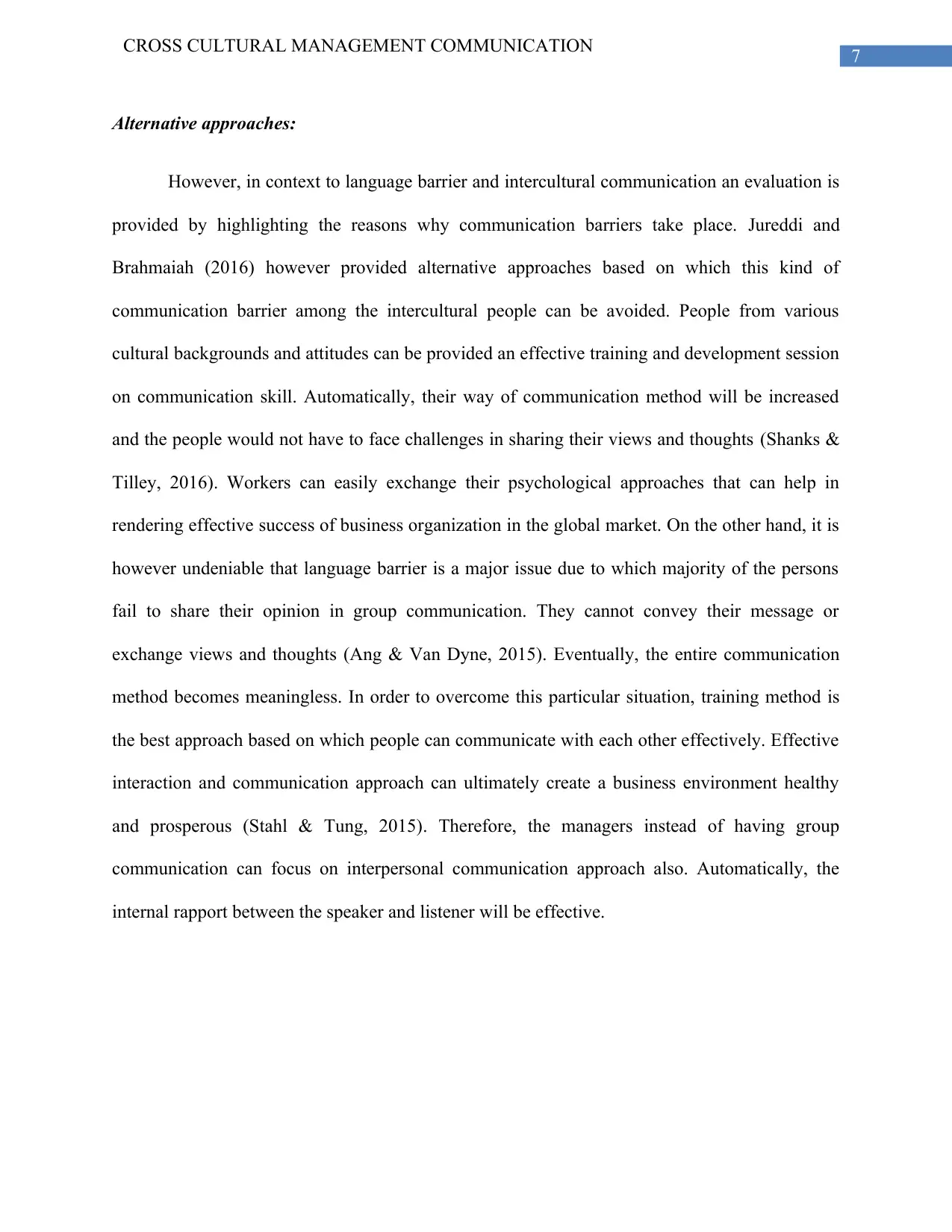
7
CROSS CULTURAL MANAGEMENT COMMUNICATION
Alternative approaches:
However, in context to language barrier and intercultural communication an evaluation is
provided by highlighting the reasons why communication barriers take place. Jureddi and
Brahmaiah (2016) however provided alternative approaches based on which this kind of
communication barrier among the intercultural people can be avoided. People from various
cultural backgrounds and attitudes can be provided an effective training and development session
on communication skill. Automatically, their way of communication method will be increased
and the people would not have to face challenges in sharing their views and thoughts (Shanks &
Tilley, 2016). Workers can easily exchange their psychological approaches that can help in
rendering effective success of business organization in the global market. On the other hand, it is
however undeniable that language barrier is a major issue due to which majority of the persons
fail to share their opinion in group communication. They cannot convey their message or
exchange views and thoughts (Ang & Van Dyne, 2015). Eventually, the entire communication
method becomes meaningless. In order to overcome this particular situation, training method is
the best approach based on which people can communicate with each other effectively. Effective
interaction and communication approach can ultimately create a business environment healthy
and prosperous (Stahl & Tung, 2015). Therefore, the managers instead of having group
communication can focus on interpersonal communication approach also. Automatically, the
internal rapport between the speaker and listener will be effective.
CROSS CULTURAL MANAGEMENT COMMUNICATION
Alternative approaches:
However, in context to language barrier and intercultural communication an evaluation is
provided by highlighting the reasons why communication barriers take place. Jureddi and
Brahmaiah (2016) however provided alternative approaches based on which this kind of
communication barrier among the intercultural people can be avoided. People from various
cultural backgrounds and attitudes can be provided an effective training and development session
on communication skill. Automatically, their way of communication method will be increased
and the people would not have to face challenges in sharing their views and thoughts (Shanks &
Tilley, 2016). Workers can easily exchange their psychological approaches that can help in
rendering effective success of business organization in the global market. On the other hand, it is
however undeniable that language barrier is a major issue due to which majority of the persons
fail to share their opinion in group communication. They cannot convey their message or
exchange views and thoughts (Ang & Van Dyne, 2015). Eventually, the entire communication
method becomes meaningless. In order to overcome this particular situation, training method is
the best approach based on which people can communicate with each other effectively. Effective
interaction and communication approach can ultimately create a business environment healthy
and prosperous (Stahl & Tung, 2015). Therefore, the managers instead of having group
communication can focus on interpersonal communication approach also. Automatically, the
internal rapport between the speaker and listener will be effective.
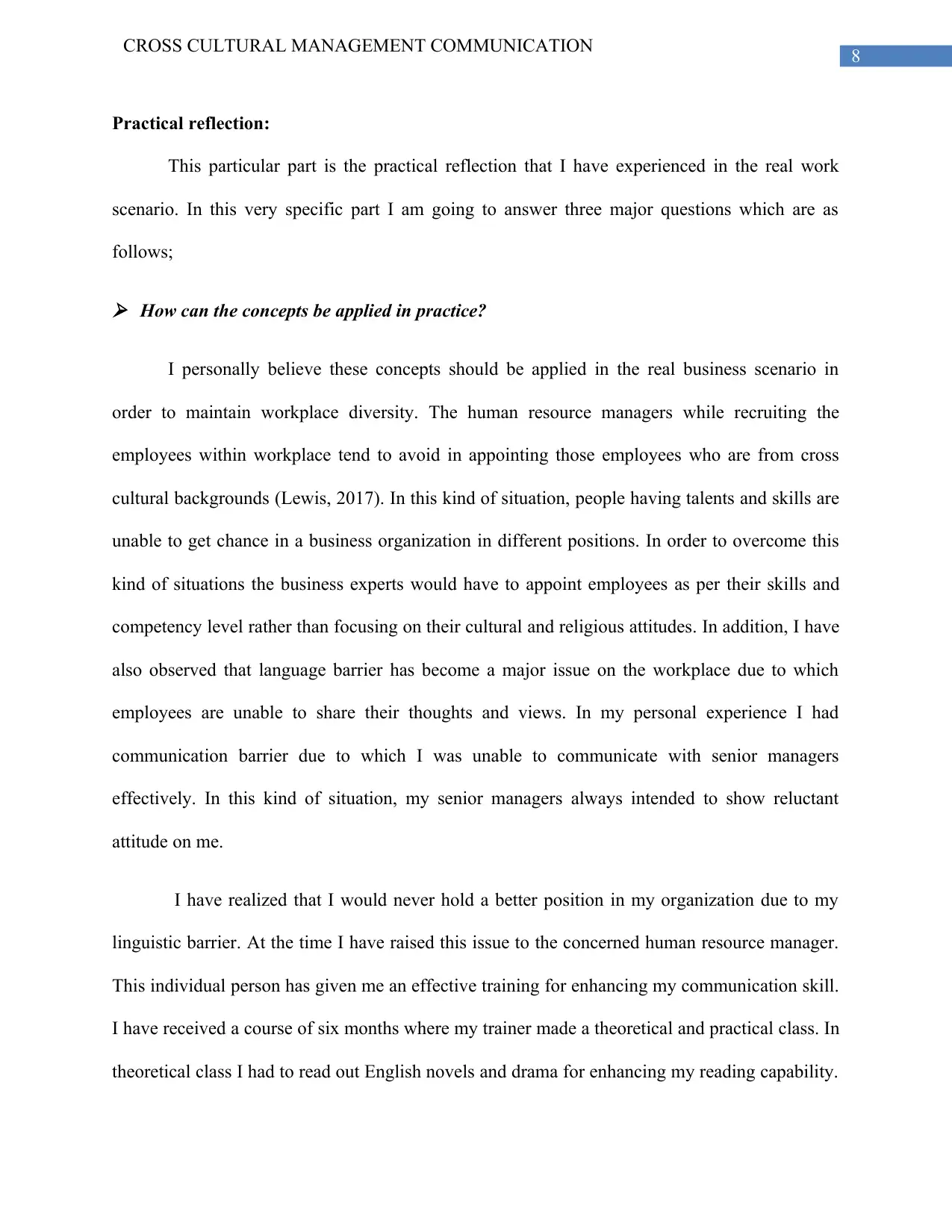
8
CROSS CULTURAL MANAGEMENT COMMUNICATION
Practical reflection:
This particular part is the practical reflection that I have experienced in the real work
scenario. In this very specific part I am going to answer three major questions which are as
follows;
How can the concepts be applied in practice?
I personally believe these concepts should be applied in the real business scenario in
order to maintain workplace diversity. The human resource managers while recruiting the
employees within workplace tend to avoid in appointing those employees who are from cross
cultural backgrounds (Lewis, 2017). In this kind of situation, people having talents and skills are
unable to get chance in a business organization in different positions. In order to overcome this
kind of situations the business experts would have to appoint employees as per their skills and
competency level rather than focusing on their cultural and religious attitudes. In addition, I have
also observed that language barrier has become a major issue on the workplace due to which
employees are unable to share their thoughts and views. In my personal experience I had
communication barrier due to which I was unable to communicate with senior managers
effectively. In this kind of situation, my senior managers always intended to show reluctant
attitude on me.
I have realized that I would never hold a better position in my organization due to my
linguistic barrier. At the time I have raised this issue to the concerned human resource manager.
This individual person has given me an effective training for enhancing my communication skill.
I have received a course of six months where my trainer made a theoretical and practical class. In
theoretical class I had to read out English novels and drama for enhancing my reading capability.
CROSS CULTURAL MANAGEMENT COMMUNICATION
Practical reflection:
This particular part is the practical reflection that I have experienced in the real work
scenario. In this very specific part I am going to answer three major questions which are as
follows;
How can the concepts be applied in practice?
I personally believe these concepts should be applied in the real business scenario in
order to maintain workplace diversity. The human resource managers while recruiting the
employees within workplace tend to avoid in appointing those employees who are from cross
cultural backgrounds (Lewis, 2017). In this kind of situation, people having talents and skills are
unable to get chance in a business organization in different positions. In order to overcome this
kind of situations the business experts would have to appoint employees as per their skills and
competency level rather than focusing on their cultural and religious attitudes. In addition, I have
also observed that language barrier has become a major issue on the workplace due to which
employees are unable to share their thoughts and views. In my personal experience I had
communication barrier due to which I was unable to communicate with senior managers
effectively. In this kind of situation, my senior managers always intended to show reluctant
attitude on me.
I have realized that I would never hold a better position in my organization due to my
linguistic barrier. At the time I have raised this issue to the concerned human resource manager.
This individual person has given me an effective training for enhancing my communication skill.
I have received a course of six months where my trainer made a theoretical and practical class. In
theoretical class I had to read out English novels and drama for enhancing my reading capability.
⊘ This is a preview!⊘
Do you want full access?
Subscribe today to unlock all pages.

Trusted by 1+ million students worldwide
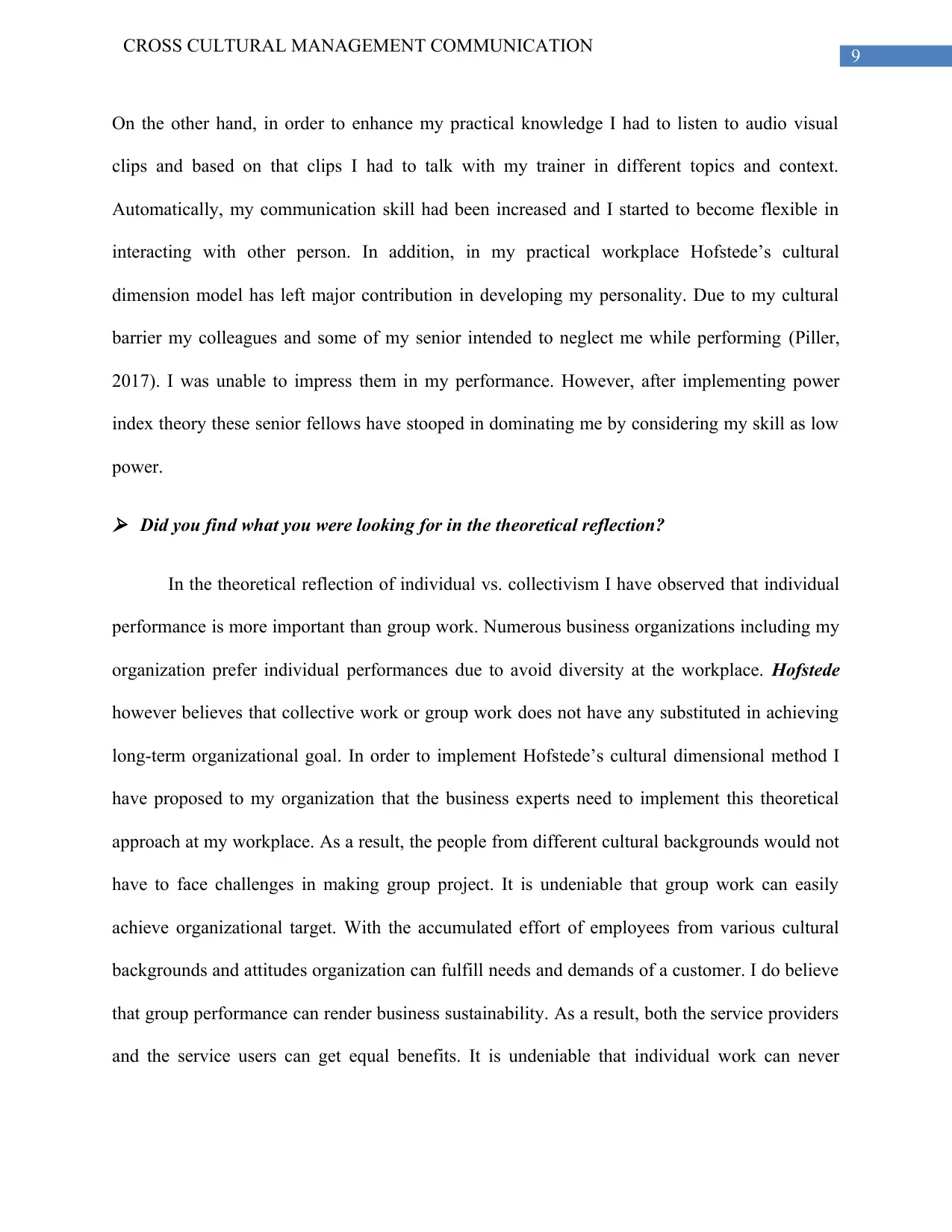
9
CROSS CULTURAL MANAGEMENT COMMUNICATION
On the other hand, in order to enhance my practical knowledge I had to listen to audio visual
clips and based on that clips I had to talk with my trainer in different topics and context.
Automatically, my communication skill had been increased and I started to become flexible in
interacting with other person. In addition, in my practical workplace Hofstede’s cultural
dimension model has left major contribution in developing my personality. Due to my cultural
barrier my colleagues and some of my senior intended to neglect me while performing (Piller,
2017). I was unable to impress them in my performance. However, after implementing power
index theory these senior fellows have stooped in dominating me by considering my skill as low
power.
Did you find what you were looking for in the theoretical reflection?
In the theoretical reflection of individual vs. collectivism I have observed that individual
performance is more important than group work. Numerous business organizations including my
organization prefer individual performances due to avoid diversity at the workplace. Hofstede
however believes that collective work or group work does not have any substituted in achieving
long-term organizational goal. In order to implement Hofstede’s cultural dimensional method I
have proposed to my organization that the business experts need to implement this theoretical
approach at my workplace. As a result, the people from different cultural backgrounds would not
have to face challenges in making group project. It is undeniable that group work can easily
achieve organizational target. With the accumulated effort of employees from various cultural
backgrounds and attitudes organization can fulfill needs and demands of a customer. I do believe
that group performance can render business sustainability. As a result, both the service providers
and the service users can get equal benefits. It is undeniable that individual work can never
CROSS CULTURAL MANAGEMENT COMMUNICATION
On the other hand, in order to enhance my practical knowledge I had to listen to audio visual
clips and based on that clips I had to talk with my trainer in different topics and context.
Automatically, my communication skill had been increased and I started to become flexible in
interacting with other person. In addition, in my practical workplace Hofstede’s cultural
dimension model has left major contribution in developing my personality. Due to my cultural
barrier my colleagues and some of my senior intended to neglect me while performing (Piller,
2017). I was unable to impress them in my performance. However, after implementing power
index theory these senior fellows have stooped in dominating me by considering my skill as low
power.
Did you find what you were looking for in the theoretical reflection?
In the theoretical reflection of individual vs. collectivism I have observed that individual
performance is more important than group work. Numerous business organizations including my
organization prefer individual performances due to avoid diversity at the workplace. Hofstede
however believes that collective work or group work does not have any substituted in achieving
long-term organizational goal. In order to implement Hofstede’s cultural dimensional method I
have proposed to my organization that the business experts need to implement this theoretical
approach at my workplace. As a result, the people from different cultural backgrounds would not
have to face challenges in making group project. It is undeniable that group work can easily
achieve organizational target. With the accumulated effort of employees from various cultural
backgrounds and attitudes organization can fulfill needs and demands of a customer. I do believe
that group performance can render business sustainability. As a result, both the service providers
and the service users can get equal benefits. It is undeniable that individual work can never
Paraphrase This Document
Need a fresh take? Get an instant paraphrase of this document with our AI Paraphraser
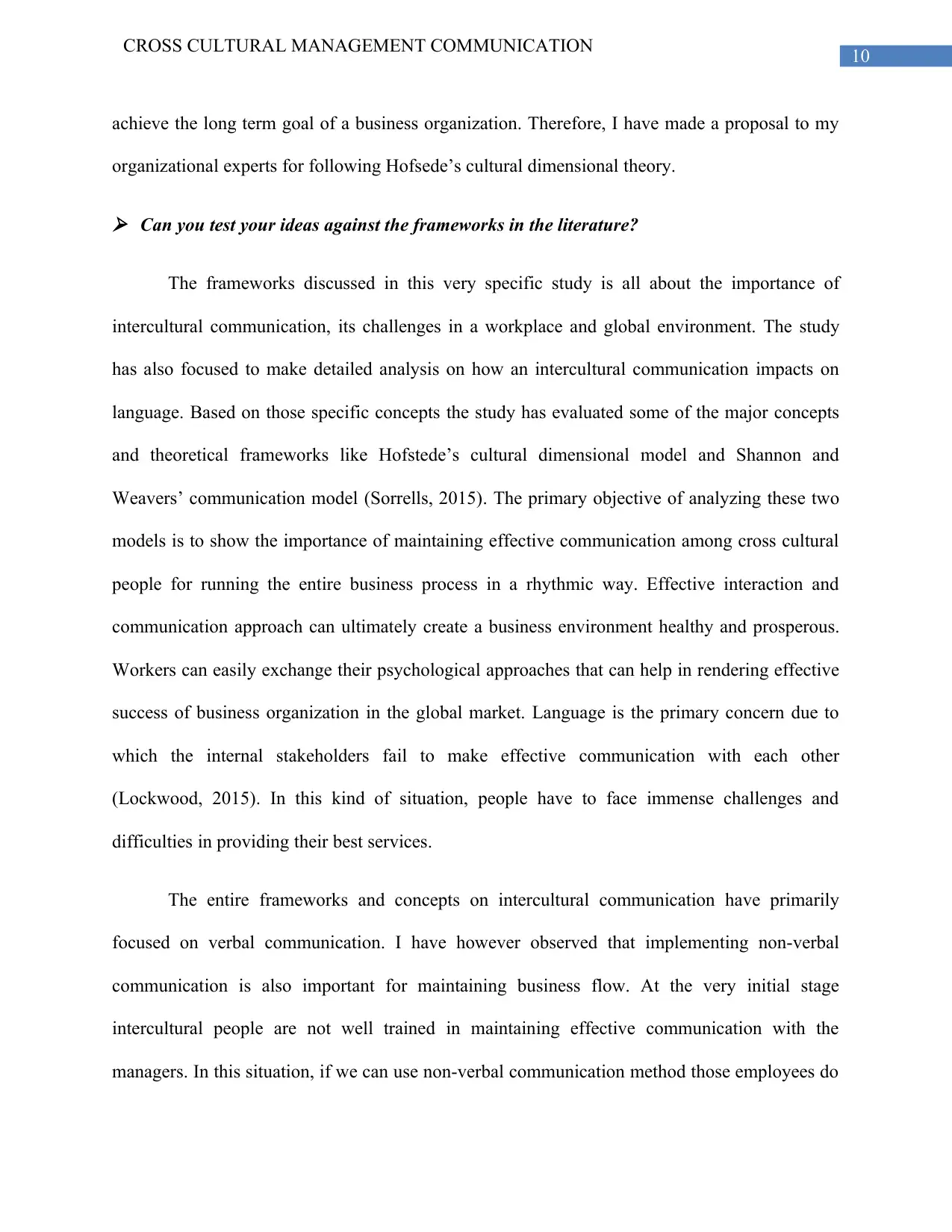
10
CROSS CULTURAL MANAGEMENT COMMUNICATION
achieve the long term goal of a business organization. Therefore, I have made a proposal to my
organizational experts for following Hofsede’s cultural dimensional theory.
Can you test your ideas against the frameworks in the literature?
The frameworks discussed in this very specific study is all about the importance of
intercultural communication, its challenges in a workplace and global environment. The study
has also focused to make detailed analysis on how an intercultural communication impacts on
language. Based on those specific concepts the study has evaluated some of the major concepts
and theoretical frameworks like Hofstede’s cultural dimensional model and Shannon and
Weavers’ communication model (Sorrells, 2015). The primary objective of analyzing these two
models is to show the importance of maintaining effective communication among cross cultural
people for running the entire business process in a rhythmic way. Effective interaction and
communication approach can ultimately create a business environment healthy and prosperous.
Workers can easily exchange their psychological approaches that can help in rendering effective
success of business organization in the global market. Language is the primary concern due to
which the internal stakeholders fail to make effective communication with each other
(Lockwood, 2015). In this kind of situation, people have to face immense challenges and
difficulties in providing their best services.
The entire frameworks and concepts on intercultural communication have primarily
focused on verbal communication. I have however observed that implementing non-verbal
communication is also important for maintaining business flow. At the very initial stage
intercultural people are not well trained in maintaining effective communication with the
managers. In this situation, if we can use non-verbal communication method those employees do
CROSS CULTURAL MANAGEMENT COMMUNICATION
achieve the long term goal of a business organization. Therefore, I have made a proposal to my
organizational experts for following Hofsede’s cultural dimensional theory.
Can you test your ideas against the frameworks in the literature?
The frameworks discussed in this very specific study is all about the importance of
intercultural communication, its challenges in a workplace and global environment. The study
has also focused to make detailed analysis on how an intercultural communication impacts on
language. Based on those specific concepts the study has evaluated some of the major concepts
and theoretical frameworks like Hofstede’s cultural dimensional model and Shannon and
Weavers’ communication model (Sorrells, 2015). The primary objective of analyzing these two
models is to show the importance of maintaining effective communication among cross cultural
people for running the entire business process in a rhythmic way. Effective interaction and
communication approach can ultimately create a business environment healthy and prosperous.
Workers can easily exchange their psychological approaches that can help in rendering effective
success of business organization in the global market. Language is the primary concern due to
which the internal stakeholders fail to make effective communication with each other
(Lockwood, 2015). In this kind of situation, people have to face immense challenges and
difficulties in providing their best services.
The entire frameworks and concepts on intercultural communication have primarily
focused on verbal communication. I have however observed that implementing non-verbal
communication is also important for maintaining business flow. At the very initial stage
intercultural people are not well trained in maintaining effective communication with the
managers. In this situation, if we can use non-verbal communication method those employees do
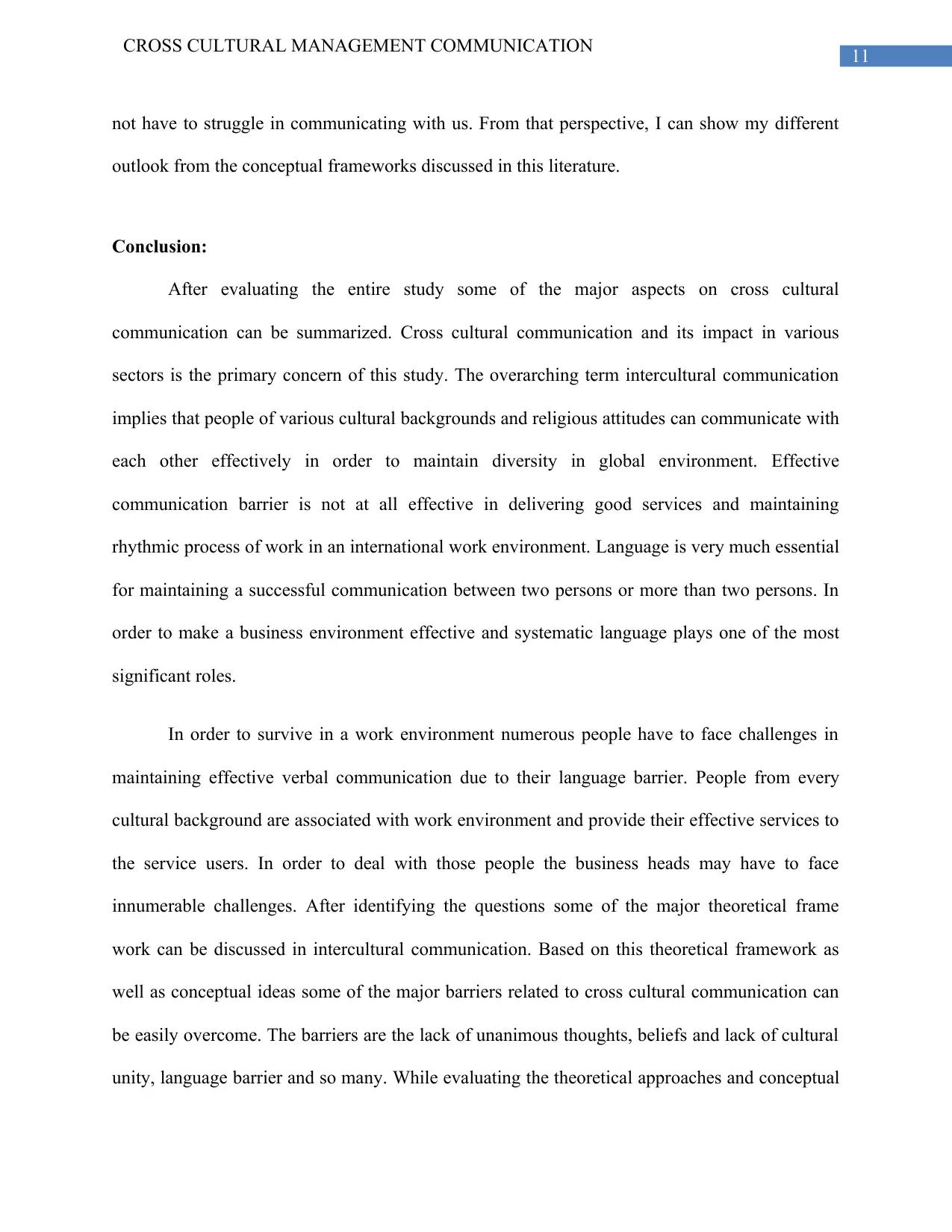
11
CROSS CULTURAL MANAGEMENT COMMUNICATION
not have to struggle in communicating with us. From that perspective, I can show my different
outlook from the conceptual frameworks discussed in this literature.
Conclusion:
After evaluating the entire study some of the major aspects on cross cultural
communication can be summarized. Cross cultural communication and its impact in various
sectors is the primary concern of this study. The overarching term intercultural communication
implies that people of various cultural backgrounds and religious attitudes can communicate with
each other effectively in order to maintain diversity in global environment. Effective
communication barrier is not at all effective in delivering good services and maintaining
rhythmic process of work in an international work environment. Language is very much essential
for maintaining a successful communication between two persons or more than two persons. In
order to make a business environment effective and systematic language plays one of the most
significant roles.
In order to survive in a work environment numerous people have to face challenges in
maintaining effective verbal communication due to their language barrier. People from every
cultural background are associated with work environment and provide their effective services to
the service users. In order to deal with those people the business heads may have to face
innumerable challenges. After identifying the questions some of the major theoretical frame
work can be discussed in intercultural communication. Based on this theoretical framework as
well as conceptual ideas some of the major barriers related to cross cultural communication can
be easily overcome. The barriers are the lack of unanimous thoughts, beliefs and lack of cultural
unity, language barrier and so many. While evaluating the theoretical approaches and conceptual
CROSS CULTURAL MANAGEMENT COMMUNICATION
not have to struggle in communicating with us. From that perspective, I can show my different
outlook from the conceptual frameworks discussed in this literature.
Conclusion:
After evaluating the entire study some of the major aspects on cross cultural
communication can be summarized. Cross cultural communication and its impact in various
sectors is the primary concern of this study. The overarching term intercultural communication
implies that people of various cultural backgrounds and religious attitudes can communicate with
each other effectively in order to maintain diversity in global environment. Effective
communication barrier is not at all effective in delivering good services and maintaining
rhythmic process of work in an international work environment. Language is very much essential
for maintaining a successful communication between two persons or more than two persons. In
order to make a business environment effective and systematic language plays one of the most
significant roles.
In order to survive in a work environment numerous people have to face challenges in
maintaining effective verbal communication due to their language barrier. People from every
cultural background are associated with work environment and provide their effective services to
the service users. In order to deal with those people the business heads may have to face
innumerable challenges. After identifying the questions some of the major theoretical frame
work can be discussed in intercultural communication. Based on this theoretical framework as
well as conceptual ideas some of the major barriers related to cross cultural communication can
be easily overcome. The barriers are the lack of unanimous thoughts, beliefs and lack of cultural
unity, language barrier and so many. While evaluating the theoretical approaches and conceptual
⊘ This is a preview!⊘
Do you want full access?
Subscribe today to unlock all pages.

Trusted by 1+ million students worldwide
1 out of 16
Related Documents
Your All-in-One AI-Powered Toolkit for Academic Success.
+13062052269
info@desklib.com
Available 24*7 on WhatsApp / Email
![[object Object]](/_next/static/media/star-bottom.7253800d.svg)
Unlock your academic potential
Copyright © 2020–2025 A2Z Services. All Rights Reserved. Developed and managed by ZUCOL.





